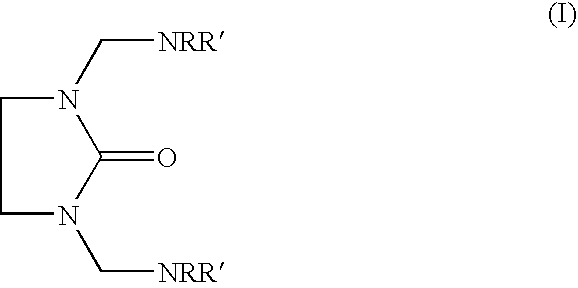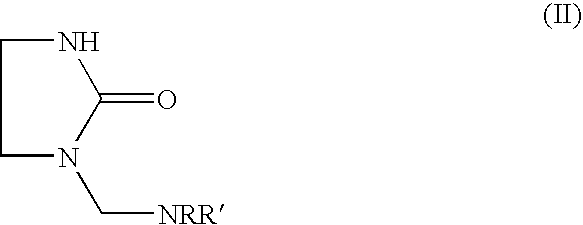Epoxy hardener systems based on aminomethylene-ethyleneureas
a technology of ethyleneurea and aminomethylene, which is applied in the field of epoxy hardeners, can solve the problems of increasing the cure time and presenting very difficult design problems, and achieve the effect of short cure time and long latency period
- Summary
- Abstract
- Description
- Claims
- Application Information
AI Technical Summary
Benefits of technology
Problems solved by technology
Method used
Image
Examples
example 1
2EU / DEAPA
[0059] This hardener was prepared by reacting 2 moles ethyleneurea with one mole DEAPA [3-(diethylamino)propylamine] and 2 moles formaldehyde according to the procedure previously described and is an example of Structure VI. It is both a chain extender and a catalytic hardener. The physical form of this material was a highly viscous resin at ambient temperature. The recommended minimum concentration in Epon828 is 7.5 phr. 20 phr of this hardener (a large excess) was blended with Epon828 and maintained at ambient temperature, resulting in a three-fold viscosity increase after 4 hours. The cure time was 1 hour at 75 degrees C.
example 2
2EU / EDA
[0060] Two moles ethyleneurea and 1 mole ethylenediamine were reacted with 2 moles formaldehyde according to the standard procedure giving a material shown in Structure VIII. This hardener is capable of chain extension only, having no tertiary amine group and is best described as an epoxy modifier. This material was then blended with Epon828 at a concentration of 10 phr and the mixture heated at 1,00 degrees C. for 1.5 hours, giving a product which was a medium viscosity liquid hot and highly viscous at ambient temperature. After one month at ambient temperature with occasional reheats to temperatures as high as 130 degrees C., the modified epoxy was a tacky, flexible semi-solid at ambient temperature. This system has a tendency to increase viscosity slowly over extended periods of time but does not appear to crosslink and remains fusible.
example 3
2EU / API Reacted with DMBA
[0061] Two moles ethyleneurea were reacted with 1 mole 1-(3-aminopropyl)imidazole (API) and 2 moles formaldehyde giving a material as shown in Structure VI. A test sample was then prepared using 7.0 phr of this hardener in Epon828. The pot life at ambient temperature was 4 hours. The cure time was 1.5 hours at 80 degrees C.
[0062] A second sample was then prepared using 6.0 phr of this hardener but adding one mole (2.77 phr) DMBA [2,2-bis(hydroxymethyl)butyricacid] per mole 2EU / API and heating for 15 minutes at 100 degrees C. to fully dissolve the acid in the ureidoamine. 4.0 phr 2EU / EDA was then added as a solubilizer. This sample was cured in 1 hour at 120 degrees C.
[0063] The viscosity increased by 2.5 times during the first 2 days at ambient temperature. This was due to the slow reaction of the non-catalytic epoxy modifier 2EU / EDA with the epoxy and is a “conditioning period”. The viscosity of the epoxy-hardener mixture at the end of 23 additional days...
PUM
| Property | Measurement | Unit |
|---|---|---|
| molar ratio | aaaaa | aaaaa |
| cure time | aaaaa | aaaaa |
| cure time | aaaaa | aaaaa |
Abstract
Description
Claims
Application Information
 Login to View More
Login to View More - R&D
- Intellectual Property
- Life Sciences
- Materials
- Tech Scout
- Unparalleled Data Quality
- Higher Quality Content
- 60% Fewer Hallucinations
Browse by: Latest US Patents, China's latest patents, Technical Efficacy Thesaurus, Application Domain, Technology Topic, Popular Technical Reports.
© 2025 PatSnap. All rights reserved.Legal|Privacy policy|Modern Slavery Act Transparency Statement|Sitemap|About US| Contact US: help@patsnap.com



